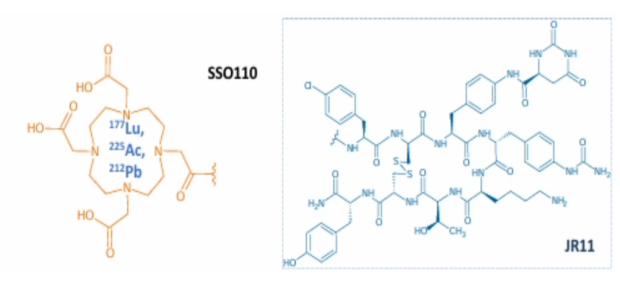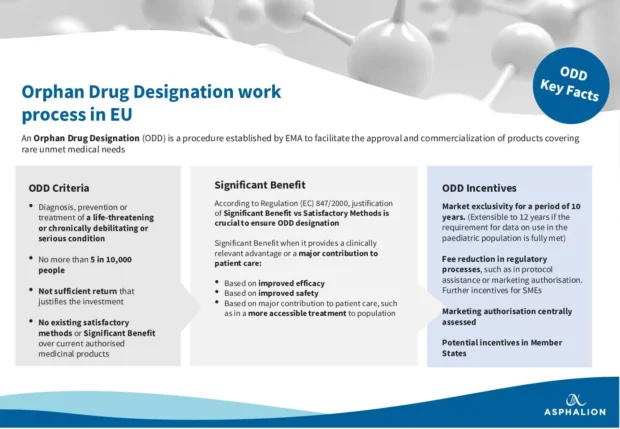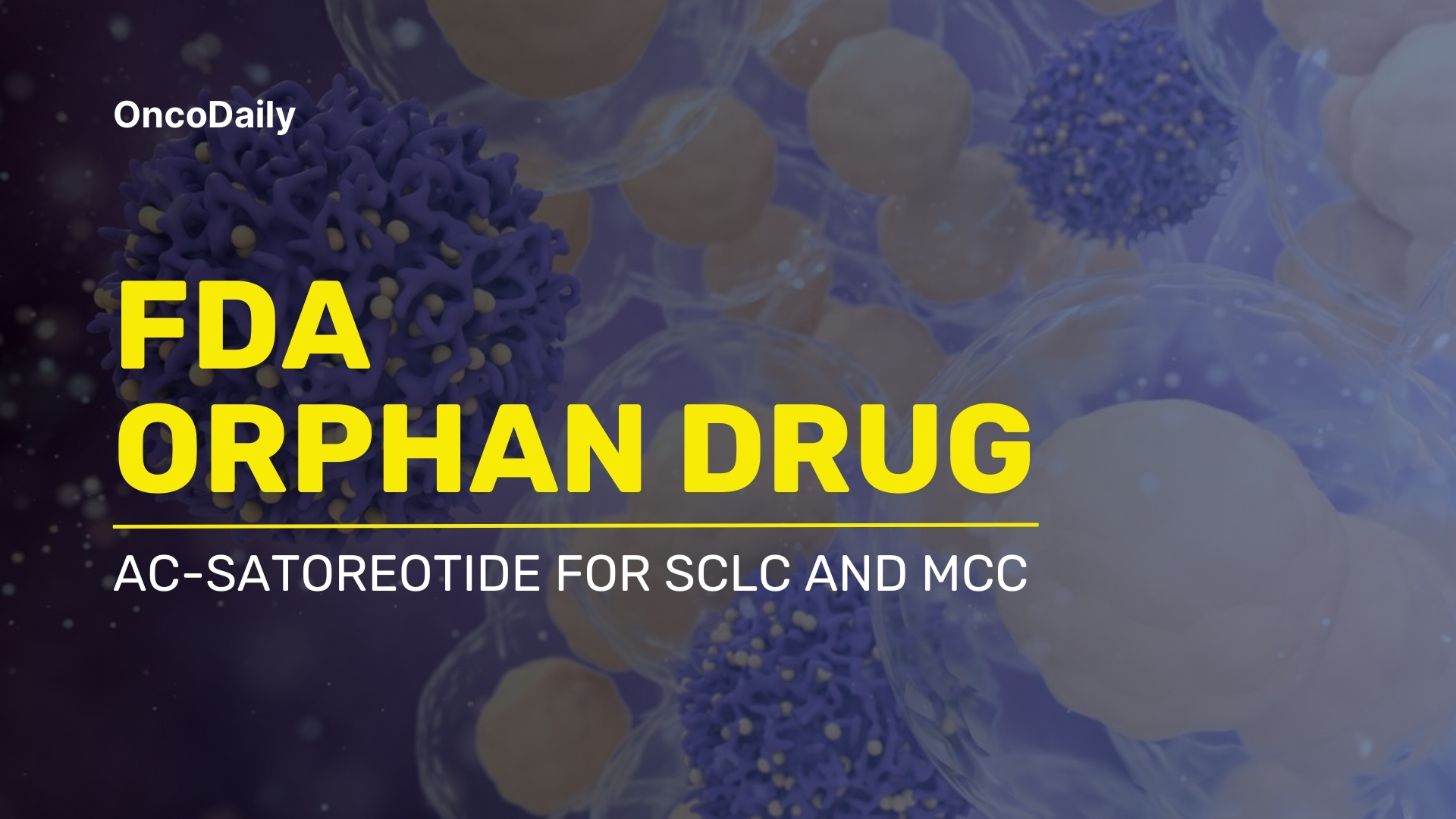In February 2025, the U.S. Food and Drug Administration (FDA) granted Orphan Drug Designation (ODD) to AC-satoreotide, a next-generation somatostatin receptor 2 (SSTR2) inhibitor, for the treatment of small cell lung cancer (SCLC) and Merkel cell carcinoma (MCC). Developed by Ariceum Therapeutics, AC-satoreotide is a promising radiopharmaceutical that selectively targets SSTR2-expressing tumors, delivering precision radiation therapy while minimizing damage to healthy tissues. This designation underscores the potential of AC-satoreotide in addressing rare and aggressive cancers with limited treatment options, paving the way for its clinical evaluation in the upcoming SANTANA-225 Phase 1/2 trial.
What is satoreotide and how does it work ?
AC-satoreotide is a new generation somatostatin 2 receptor inhibitor which is bound to radioactive agent and It targets tumors, which express somatostatin and have somatostatin receptors.
Somatostatin is a regulatory peptide involved in inhibiting hormone secretion, cell proliferation, and neurotransmission. SSTR2 receptor is one of five G-protein-coupled receptors (SSTR1–SSTR5) that mediate the effects of somatostatin.

Over the past two decades, peptide receptor radionuclide therapy (PRRT) has become a highly promising treatment for neuroendocrine tumors (NETs), with expanding clinical applications. This approach involves attaching a radiometal to a somatostatin receptor (SSTR) ligand, enabling precise delivery of radiation directly to cancer cells.
PRRT primarily uses beta (β) or alpha (α) radiation from nuclear decay. This radiation causes DNA damage in tumor cells through direct or indirect ionization, leading to apoptosis. AC-satoreotide binds to SSTR2-positive tumor cells with high specificity and delivers radiation targeted to the cell which overexpresses SSTR2, which causes DNA damage via direct ionization or free radical formation, leading to apoptosis.
One of the most important benefits is that by this mechanism it minimizes toxicity to healthy tissue, because the radiation used in PRRT has a short penetration range, reducing damage to surrounding healthy cells.
What trial is going to be held with AC-satoreotide?
Currently the FDA has approved the investigational new drug (IND) application for 225Ac-SSO110 (satoreotide), enabling the initiation of a Phase 1/2 trial for treating patients with small cell lung cancer (SCLC) or Merkel cell carcinoma (MCC). The SANTANA-225 trial will evaluate the safety, tolerability, and preliminary efficacy of 225Ac-SSO110 in patients with extensive-stage SCLC (ES-SCLC) and MCC. Patient enrollment for the trial is anticipated to begin in the first quarter of 2025.
Why mainly SCLC and MCC?
Many small cell lung cancer (SCLC) and Merkel cell carcinoma (MCC) cases overexpress somatostatin receptor 2 (SSTR2) and are both highly aggressive tumors with limited treatment options, and potentially PRRT may offer a novel targeted approach for patients.
Eventually what is Orphan Drug Designation Status?
Orphan drugs are pharmaceutical agents designed to treat rare and “orphan” diseases. In the U.S., a disease is considered rare if it affects fewer than 200,000 people and in UE the threshold is fewer than 5 in 10,000 people.

Generally it takes years and many trials in order to have FDA approval for the drug and only after being approved by FDA pharma companies can sell new medications. It is not profitable to generate a new drug for a rare disease, and that’s why many rare diseases were neglected by pharma companies and they were called “ orphan diseases”. In order to improve the research and new drug development for these diseases, the U.S. The Orphan Drug Act (ODA) was signed in 1983 into law, which provides financial incentives, market exclusivity (7 years in the U.S., 10 years in the EU), and tax credits. The FDA provides ODD to drugs and biologics that demonstrate potential for the diagnosis and/or treatment of rare diseases.
The preliminary study that supported the Orphan Drug Designation (ODD) for AC-satoreotide
225Ac-SSO110 induces long-lasting antitumor responses in contrast to 225Ac-DOTA-TATE and 161Tb-DOTA-TATE in the treatment of SSTR2-positive tumour xenografts
The study evaluated the anti-tumor efficacy of 225Ac-Satoreotide against other radiolabeled agents, specifically comparing it to 225Ac-DOTA-TATE and 161Tb-DOTA-TATE. The experiments utilized SSTR2-positive tumor xenografts implanted in mice, including models of SCLC and pancreatic cancer. The primary focus was to assess the pharmacokinetic profile, tumor response, and survival rates across various radiolabeled peptides.

Manfred Rüdiger, Chief Executive Officer at Ariceum Therapeutics, said:
“These results provide strong evidence for satoreotide and its potential to clinically outperform SSTR2 targeting agonists, by demonstrating significantly better efficacy in tumour growth control, up to complete tumour eradication depending on isotope used. In addition, when a single dose of 30 kBq 225Ac-satoreotide was administered, we observed a high frequency of complete durable responses and 100% survival which strongly supports further clinical development for the treatment of SCLC, MCC and other cancers.”
This study was an in-vivo comparison of the pharmacokinetics and anti-tumor effects of 225Ac-Satoreotide and 225Ac-DOTA-TATE (both labeled with the same radionuclide), as well as 161Tb-DOTA-TATE.
The results showed that 225Ac-Satoreotide exhibited a superior pharmacokinetic profile compared to DOTA-TATE, with higher pre-clinical anti-tumor efficacy, irrespective of the radionuclide used. Notably, 225Ac-Satoreotide demonstrated 100% survival in the mouse models following a single dose of 30 kBq. In contrast, 225Ac-DOTA-TATE did not achieve this level of survival. These findings underline the significant potential of 225Ac-Satoreotide as a more effective treatment option for SSTR2-positive tumors.
Written by Sona Karamyan, MD
